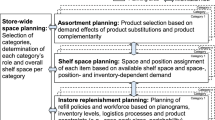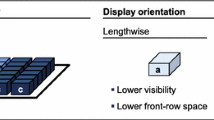Abstract
In this paper, we model a shelf-management problem in which individual products are categorized as part of a product family. It is well known that a product’s shelf location has a significant impact on sales for many retail items. We develop a continuous as well as a discrete model with postprocessing to optimize product placement with consideration given to maintaining the grouping of product families. Computational results are reported on test problems as well as real-world beverage placement problems.
Similar content being viewed by others
References
Amrouche, N., & Zaccour, G. (2007). Shelf-space allocation of national and private brands. European Journal of Operational Research, 180(2), 648–663.
Anderson, E. E., & Amato, H. N. (1974). A mathematical model for simultaneously determining the optimal brand-collection and display-area allocation. Operations Research, 22(1), 13–21.
Borin, N., Farris, P. W., & Freeland, J. R. (1994). A model for determining retail product category assortment and shelf space allocation. Decision Sciences, 25(3), 359–384.
Bultez, A., & Naert, P. (1988). SH.A.R.P.: shelf allocation for retailers’ profit. Marketing Science, 7(3), 211–231.
Chen, Y.-L., Chen, J.-M., & Tung, C.-W. (2006). A data mining approach for retail knowledge discovery with consideration of the effect of shelf-space adjacency on sales. Decision Support Systems, 42(3), 1503–1520.
Corstjens, M., & Doyle, P. (1981). A model for optimizing retail space allocations. Management Science, 27(7), 822–833.
Drèze, X., Hoch, S. J., & Purk, M. E. (1994). Shelf management and space elasticity. Journal of Retailing, 70(4), 301–326.
Esparcia-Alcázar, A. I., Lluch-Revert, L., Sharman, K. C., Albarracín-Guillem, J. M., & Palmer-Gato, M. E. (2006). Towards an evolutionary tool for the allocation of supermarket shelf space. In Proceedings of the eighth annual conference on genetic and evolutionary computation, Seattle, pp. 1653–1660.
Frank, R. E., & Massy, W. F. (1970). Shelf position and space effects on sales. Journal of Marketing Research, 7(1), 59–66.
Hariga, M. A., Al-Ahmari, A., & Mohamed, A.-R. A. (2007). A joint optimization model for inventory replenishment, product assortment, shelf space and display area allocation decisions. European Journal of Operational Research, 181(1), 239–251.
Hoare, N. P., & Beasley, J. E. (2001). Placing boxes on shelves: a case study. Journal of the Operational Research Society, 52(6), 605–614.
Hwang, H., Choi, B., & Lee, M.-J. (2005). A model for shelf space allocation and inventory control considering location and inventory level effects on demand. International Journal of Production Economics, 97(2), 185–195.
ILOG, Inc. (2006). ILOG CPLEX offers industry-first features for real-world planning and scheduling tasks, available online 21 February 2006, http://www.ilog.com/corporate/releases/us/060221_cplex.cfm, accessed 13 June 2007.
Irion, J., Al-Khayyal, F., & Lu, J.-Ch. (2004). A piecewise linearization framework for retail shelf space management models (Technical Report). School of Industrial and Systems Engineering, Georgia Institute of Technology, Atlanta.
Kök, A. G., & Fisher, M. L. (2007). Demand estimation and assortment optimization under substitution: methodology and application. Operations Research, 55(6), 1001–1021.
Kök, A. G., Fisher, M. L., & Vaidyanathan, R. (2006). Assortment planning: review of literature and industry practice. In N. Agrawal & S. A. Smith (Eds.), Retail supply chain management. Amsterdam: Kluwer Academic.
Larson, J. S., Bradlow, E. T., & Fader, P. S. (2005). An exploratory look at supermarket shopping paths. International Journal of Research in Marketing, 22(4), 395–414.
Lim, A., Rodrigues, B., & Zhang, X. (2004). Metaheuristics with local search techniques for retail shelf-space optimization. Management Science, 50(1), 117–131.
Martín-Herrán, G., Taboubi, S., & Zaccour, G. (2006). The impact of manufacturers’ wholesale prices on a retailer’s shelf-space and pricing decisions. Decision Sciences, 37(1), 71–90.
Reyes, P. M., & Frazier, G. V. (2007). Goal programming model for grocery shelf space allocation. European Journal of Operational Research, 181(2), 634–644.
Sherer, M. (1999). Improving your shelf image. Beverage & Food Dynamics, available online http://www.beveragenet.net/bd/1999/0199/199imp.asp.
Underhill, P. (1999). Why we buy: the science of shopping. New York: Simon & Schuster.
Urban, G. L. (1969). A mathematical modeling approach to product line decisions. Journal of Marketing Research, 6(1), 40–47.
Urban, T. L. (1998). An inventory-theoretic approach to product assortment and shelf-space allocation. Journal of Retailing, 74(1), 15–35.
Yang, M.-H. (2001). An efficient algorithm to allocate shelf space. European Journal of Operational Research, 131(1), 107–118.
Yang, M.-H., & Chen, W.-C. (1999). A study on shelf space allocation and management. International Journal of Production Economics, 60–61(1–3), 309–317.
Zufryden, F. S. (1986). A dynamic programming approach for product selection and supermarket shelf-space allocation. Journal of the Operational Research Society, 37(4), 413–422.
Author information
Authors and Affiliations
Corresponding author
Rights and permissions
About this article
Cite this article
Russell, R.A., Urban, T.L. The location and allocation of products and product families on retail shelves. Ann Oper Res 179, 131–147 (2010). https://doi.org/10.1007/s10479-008-0450-y
Published:
Issue Date:
DOI: https://doi.org/10.1007/s10479-008-0450-y




